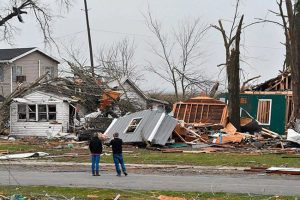Homeowners insurance is a necessity for protecting your home and belongings from unexpected events like natural disasters, theft, and accidents. Allstate Insurance is one of the leading insurance providers in the United States, offering a variety of coverage options to cater to the unique needs of homeowners across the country. However, it’s important to understand that Allstate homeowners insurance policies can differ from state to state.
In this article, we will explore the reasons behind these variations and provide insights into how you can choose the best coverage for your specific location.
Table of contents
State Regulations and Requirements
State regulations and requirements play a significant role in determining the differences in Allstate homeowners insurance policies among different states. Each state has its own set of rules and regulations that insurance companies must follow. These regulations can dictate things like minimum coverage limits, types of coverage that must be included, and mandatory endorsements that must be added to a policy. For example, in Florida, homeowners insurance policies must include coverage for windstorms and hurricanes, while in California, earthquake coverage may be required.
Allstate adjusts its policies to comply with each state’s regulations, which can lead to variations in coverage among different states. This means that coverage and policy options available in one state may not be available in another. For example, some states may require additional coverage for flooding, while others may not.
It’s important to note that state regulations can also impact the cost of homeowners insurance policies. For example, states that are prone to natural disasters may have higher insurance premiums due to the increased risk of property damage. Insurance companies may also be required to offer discounts or incentives for certain safety features, such as smoke detectors or security systems.
Understanding the state-specific regulations and requirements for homeowners insurance is essential when shopping for a policy. It’s important to work with an insurance agent who is knowledgeable about the regulations in your state and can help you find a policy that meets your specific needs and budget. By doing so, you can ensure that you have the right coverage in place to protect your home and personal belongings.
Regional Risks and Natural Disasters
In addition to state regulations, Allstate also takes into account regional risks and natural disasters when designing its homeowners insurance policies. For instance, certain areas of the country are more prone to natural disasters such as hurricanes, earthquakes, or tornadoes, while others are more susceptible to wildfires or floods.
For instance, homeowners in California may face a higher risk of wildfires due to the state’s dry climate and landscape. In response to this, Allstate’s policies in California may offer additional coverage for wildfire damage or require homeowners to take certain preventative measures to reduce the risk of fire damage to their property.
On the other hand, homeowners in states like Florida or Louisiana may face a higher risk of damage from hurricanes or flooding. To address this, Allstate’s policies in these areas may offer more comprehensive coverage for hurricane damage or flood insurance to protect against the financial impact of a potential disaster.
By tailoring their policies to the specific risks of each region, Allstate aims to provide homeowners with the coverage they need to protect their property and minimize financial losses in the event of a natural disaster.
Local Construction and Repair Costs
Local construction and repair costs play an important role in determining the coverage limits and premiums for homeowners insurance policies. Allstate, like most other insurance companies, uses data on local building and repair costs to determine the amount of coverage needed for each specific home and the corresponding premiums.
The cost of building or repairing a home can vary significantly between different regions due to variations in the local construction market and labor costs. For example, the cost of building or repairing a home in a rural area might be lower than in an urban area due to lower labor and material costs. Allstate takes into account these differences and provides policies that align with the local construction and repair costs.
In addition, Allstate considers the type of construction materials used in different regions when determining coverage limits and premiums. Some areas may require different building materials due to weather conditions or local building codes, which can affect the cost of rebuilding or repairing a home.
It is essential to consider these regional differences and understand how they impact your coverage limits and premiums when purchasing a homeowners insurance policy. Allstate, with its state-specific policies, helps homeowners choose the right coverage that fits their needs and protects them against potential losses.
State-Specific Discounts and Incentives
In addition to state-specific regulations, risks, and costs, Allstate also offers state-specific discounts and incentives to homeowners insurance policyholders. These discounts and incentives can vary from state to state, as they are often influenced by local regulations and market conditions.
For instance, some states may offer discounts for installing specific safety features in the home, such as smoke detectors or burglar alarms, while other states may provide incentives for maintaining a good claims history. Certain states may also offer discounts for bundling multiple insurance policies, such as home and auto insurance, with Allstate.
To take advantage of these state-specific discounts and incentives, it’s important to work with an Allstate agent who is familiar with the policies and regulations in your state. They can help you identify the discounts and incentives that apply to you and ensure that you are getting the most value out of your homeowners insurance policy.
It’s worth noting that while state-specific discounts and incentives can help lower the cost of your homeowners insurance policy, it’s important to prioritize coverage that adequately protects your home and belongings. Don’t choose a policy solely based on the discounts or incentives offered, as this could leave you underinsured in the event of a loss. Instead, work with your Allstate agent to find a policy that provides the right balance of coverage and affordability for your unique situation.
How to Choose the Right Allstate Homeowners Insurance Policy
With state-specific differences in mind, it’s essential to carefully review your Allstate homeowners insurance policy and ensure that it meets your needs and complies with your state’s requirements. Here are some tips to help you make the right choice:
- Research State Regulations: Familiarize yourself with your state’s insurance regulations and requirements to understand the minimum coverage limits and any mandatory endorsements you may need.
- Assess Your Home’s Risks: Evaluate the potential risks your home may face, considering factors such as location, construction materials, and proximity to natural disaster-prone areas.
- Compare Policies and Coverages: Review multiple Allstate homeowners insurance policies to find the one that best suits your needs and budget. Look for policies that offer adequate coverage for your home’s risks and any additional coverage options you may require.
- Seek Professional Advice: Consult with an insurance agent or broker to help you navigate the complexities of homeowners insurance and ensure you’re making an informed decision.
Wrap-up
Allstate homeowners insurance policies can differ from state to state due to varying regulations, risks, and local factors. By understanding these differences and taking the time to research and compare policies, you can find the coverage that best meets your needs and protects your home and belongings. Don’t hesitate to seek professional advice and assistance in finding the right policy for your specific situation.
FAQ
Policies vary due to state-specific regulations, natural disaster risks, local construction costs, and available discounts or incentives.
Regulations dictate coverage limits, required types of coverage, and mandatory endorsements, influencing policy variations across states.
Allstate tailors policies to address regional risks like wildfires, hurricanes, or floods, affecting coverage options and premiums.
These costs influence coverage limits and premiums, as they reflect the expenses of rebuilding or repairing homes in different regions.
Yes, Allstate offers state-specific discounts for safety features, bundling policies, and maintaining a good claims history, among others.
Research state regulations, assess your home’s risks, compare policies, and consult with an insurance agent to ensure your policy meets your needs.
Prioritize coverage that adequately protects your home and belongings, considering your specific risks and state requirements.




